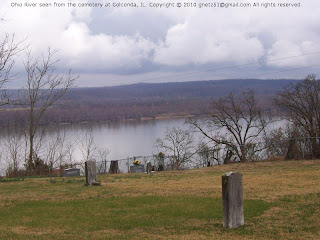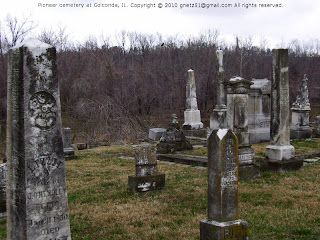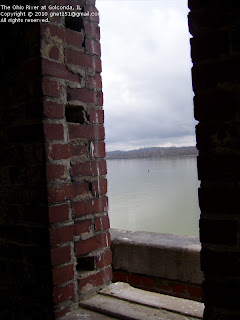Historic Ohio River town
Last Friday, I took a road trip with my daughter Keely and her fiance Taurus. One of our destinations was Golconda, the little town in southern Illinois where Taurus grew up. Golconda is located on the Ohio River, about 20 miles across the map (36 highway miles) northeast from Paducah, KY.
A bit of Golconda's history
I photographed a few paragraphs about Golconda's history on the Dari-Barr menu (image below). The Dari-Barr is a great little cafe along Highway 146 in Golconda where you can get a good plate lunch for under $5.
Golconda was one of the first towns of southern Illinois, and it remained an important river crossing and river port for many years. It was the starting-point (or end-point) of several early trails and roads through this part of the country, including the Dover, TN-Golconda stagecoach road.
As the 1800s progressed, Golconda and other settlements along the river grew and became civilized towns. One feature of life along the Ohio was a daily packet that ran back and forth from Evansville, Indiana, to Cairo, Illinois. It carried goods, freight, mail, newspapers, and travelers to and from Golconda and the other little towns on the route. (Here is an account of a river traveler's half-hour stop in Golconda, published in 1919.)
In 1902, a railroad spur was completed that connected Golconda to the Illinois Central line from Paducah to Carbondale. The rail connection multiplied the economic activity of Golconda's docks and warehouses. Because of the railroad, Golconda became an important link in the shipment of ore from the fluorspar mines of southern Illinois. (Fluorspar is the source of fluorine.) One mine regularly brought loaded boxcars by barge to Golconda and put them on the railroad. Empty boxcars were loaded onto the barges for the return trip to the mine.
In the 1920s, the construction of Lock and Dam 51 on the Ohio at Golconda brought about five years of extra jobs and bountiful income to the community. The lock and dam continued to be a substantial employer in the town until it was finally replaced by a new lock at Smithland, KY, in 1979. Taurus can remember when the old Lock and Dam 51 were dynamited.
A few things remain at the site of Lock and Dam 51 -- the "Golconda Tower" that once stood at the end of the lock, a long flight of steps leading down to the river, three houses where the lock's supervisors lived, and the building that housed the offices. The Lockmaster Homes, which have an unobstructed, close-up view of the river, have been restored by the City of Golconda and are available for short-term rental.
We stopped at the cemetery where Taurus's grandparents and other family members are buried, on top of a bluff that overlooks the Ohio River. Taurus said that the tower, steps, houses, etc. of the old lock and dam are over the edge of the bluff, a hundred feet or so below the cemetery. (I didn't try to look over the edge to see if he was right!)
Taurus's old neighborhood
Taurus also took us to see the pioneer cemetery, located on a knoll near Lusk Creek. This graveyard of the 1800s was only a block away from the house where Taurus lived with his grandparents. He told us some fearsome stories about boy-play on top of the tall concrete flood walls at the cemetery's edge.
We also stopped to see an extremely large pecan tree that grows in the neighborhood. Taurus has fond memories of this tree, and he was sad to see that some of its branches have been cut back recently. Unfortunately, English ivy has been permitted to grow up the trunk, and it is deeply rooted into the bark. (Click here to see this tree before it was trimmed (on Google Maps street view), and click here to see the house where Taurus lived.)
More to see at Golconda
Golconda has its share of fine old mansions on the bluffs overlooking the river. Some have slipped into disrepair, while others are well-maintained. Something similar could be said of the entire town. The railroad is gone, and the shipping and warehouse business is not what it used to be. Golconda is not as wealthy as it once was, but it is developing its tourist industry. New ways are being found to use the river to Golconda's benefit.
I suspect that Golconda has at least one historic marker somewhere -- probably at the courthouse. I'd like to see and explore more of this little river town.
Unfortunately, my eyesight was not at its best when we were there. I nearly put out my right eye early that morning by opening the car door into it, just before I left to meet Keely and Taurus. I didn't take as many photos as I would have ordinarily, and I even let Taurus drive my car all day. (My eye is fine now.)
This summer, I'm hoping to go back to Golconda. I also want to visit Cave In Rock, a historic site a little farther upstream on the Ohio River.
The Ohio River, seen through the
windows of the old lock tower
at Golconda, Illinois










2 comments:
What a wonderful way to, "know" your future son-in-law than to visit his roots! Also, the history of the town and its relationship to the Ohio River were very informative. -- barbara
I've always been interested in river towns. I guess that's because I'm a lifelong landlubber. Except for two little villages along the Main River in Germany, I've never lived close to a river.
Post a Comment